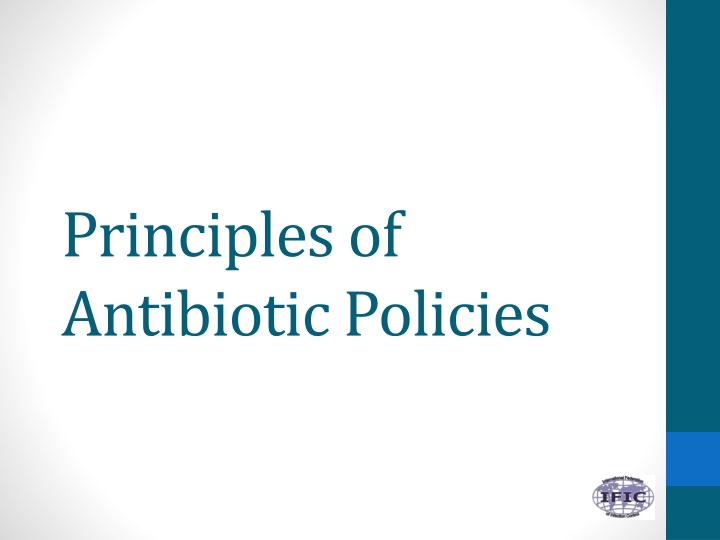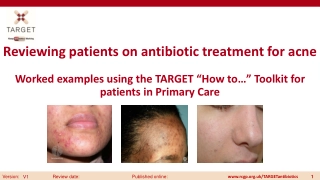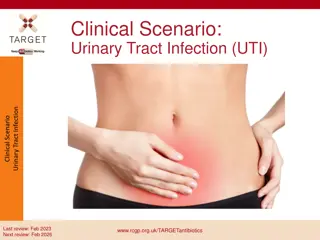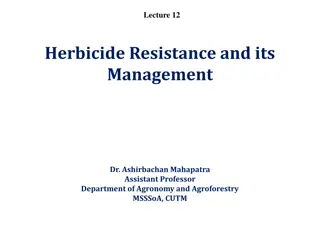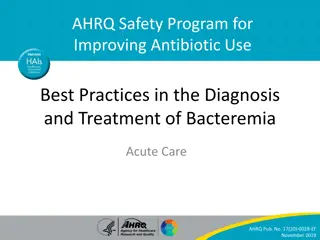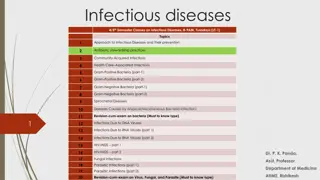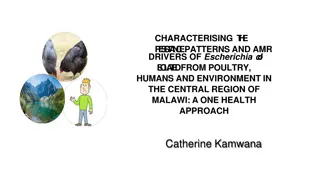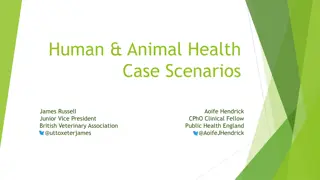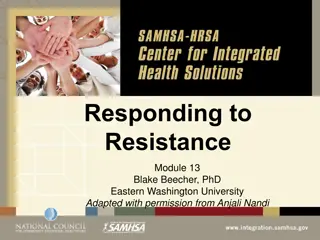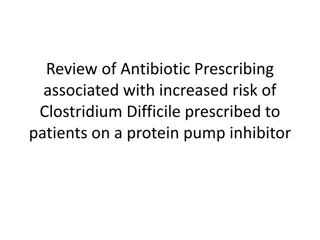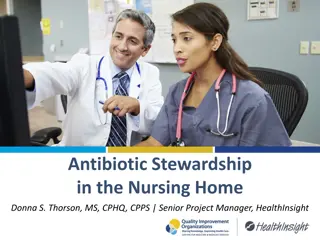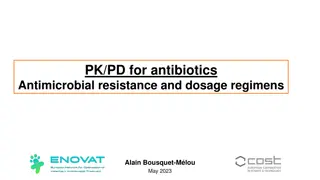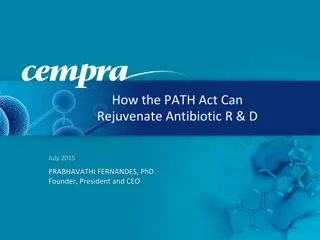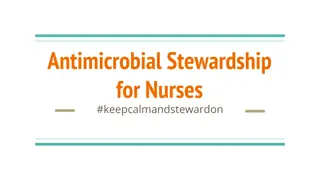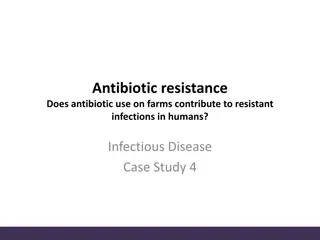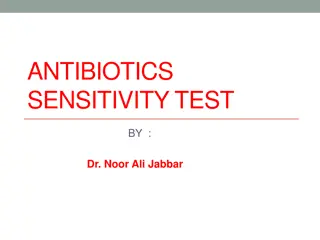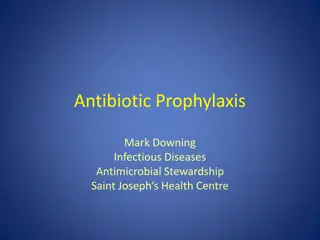Principles of Antibiotic Policies and Resistance
Antibiotic policies play a crucial role in combating antibiotic resistance. Understanding mechanisms of resistance, proper antibiotic use, and the importance of stewardship programs are key in preserving antibiotic effectiveness. The discovery of antibiotics by Fleming revolutionized medicine, but misuse has led to the development of resistant strains. Awareness and collaboration are essential to address this global health concern.
Uploaded on Sep 21, 2024 | 0 Views
Download Presentation

Please find below an Image/Link to download the presentation.
The content on the website is provided AS IS for your information and personal use only. It may not be sold, licensed, or shared on other websites without obtaining consent from the author.If you encounter any issues during the download, it is possible that the publisher has removed the file from their server.
You are allowed to download the files provided on this website for personal or commercial use, subject to the condition that they are used lawfully. All files are the property of their respective owners.
The content on the website is provided AS IS for your information and personal use only. It may not be sold, licensed, or shared on other websites without obtaining consent from the author.
E N D
Presentation Transcript
Principles of Antibiotic Policies
Learning objectives December 1, 2013 1. Explain how antibiotic use can select resistant strains of bacteria 2. Identify important mechanisms used by antibiotic stewardship programmes to decrease bacterial resistance in hospitals 3. Describe the roles of the microbiology laboratory and IP&C staff in the containment of bacterial resistance in healthcare 4. Participate in the formation of an antibiotic stewardship programme 2
Time involved December 1, 2013 45 60 minutes 3
Introduction December 1, 2013 Discovery of antibiotics revolutionary event that saved millions of lives Emergence of resistance reduced effectiveness, increased toxicity, increased costs To preserve susceptibility or to postpone development of resistance antibiotics should be used rationally 4
Antibiotics December 1, 2013 Fleming changed the course of history Mould contaminated an experiment contained penicillin Killed the Staphylococcus aureus that had been growing in the dish Penicillin altered the treatment of bacterial infections Dr Alexander Fleming 5
Antibiotic Resistance Antibiotic resistance develops Through natural mutations of bacterial genes Through transfer of resistance genes between different bacteria via plasmids, transposons, etc. If a bacterial population with newly resistant bacteria are exposed to a specific antibiotic, they will be selected and develop a new resistant strain December 1, 2013 6
Mechanisms of resistance December 1, 2013 Resistance can be mediated by: Change in antibiotic target site - altered penicillin binding proteins, altered DNA gyrase: Beta-lactams, Quinolones Production of detoxifying enzymes: Beta-lactams (Beta-lactamases) , Aminoglycosides, Chloramphenicol Decreased uptake(reduced permeability, active efflux): Erythromycin, Tetracyclines, Beta- lactams 7
Antibiotic use outside human medicine Antibiotics are used as treatment of infections In veterinary medicine In agriculture Antibiotics are also used as growth promotors December 1, 2013 8
Clinical Impact of Resistance December 1, 2013 Increased morbidity Increased mortality Extended hospital stay Increased admission to intensive care Loss of bed days 9
Types of antibiotic uses December 1, 2013 Empirical therapy Without the knowledge of pathogen Pathogen-directed therapy Knowing the pathogen and susceptibility to antibiotics Prophylaxis Surgical Medical 10
Dealing with resistance December 1, 2013 Prevention of spread Infection prevention & control in healthcare settings Isolation Hand Hygiene Environmental hygiene Reduction Usage control Appropriate use Antibiotic stewardship Surveillance Antibiotic policies & guidelines Antibiotic management programmes Human Animal Environmental 11
Antibiotic stewardship programmes - 1 December 1, 2013 Can modify prescribing practices Should lead to reduced, rational use Should be well designed, and implemented Should be based on education Ideally should be a mixture of measures that are: Voluntary Persuasive Restrictive 12
Antibiotic stewardship programmes - 2 December 1, 2013 Key to modifying prescribing practices, stewardship programmes must include: National policies Local hospital or health care policies Formularies and guidelines Education Effective microbiology laboratory support Audits Effective working relationship with IP&C* teams 13 *IP&C: Infection Prevention and Control
Key Elements of National Antibiotic Policies December 1, 2013 Legislation required to regulate production and import Legislation to impose limitation of use in veterinary practices to treatment only Not as growth promoters Legislation to reduce over the counter use Education of the general population Reduce expectations Avoid misuse and over demand 14
Hospital stewardship programmes December 1, 2013 Important elements of an effective hospital programme: Antibiotic Committee Antibiotic Management team Formularies, guidelines and protocols Education Audits 15
Antibiotic Committee Can be a stand alone Committee, or part of Drugs and Therapeutics Committee Membership should include: Physicians and nurses who prescribe antibiotics Pharmacists Microbiologists Members of Management/Administration Members of Infection Control Committee Others, as needed December 1, 2013 16
Antibiotic Management Team December 1, 2013 Team to advise on antibiotic use, audit of prescribing, introduction of new antibiotics Larger hospitals: can include infectious disease (ID) physicians, clinical pharmacologists, pharmacists, clinical microbiologists, any doctor authorised to use reserve list Smaller institutions: minimum requirement: antibiotic pharmacist (at least part-time), with support from ID or IP&C physician 17
Guidelines and Protocols December 1, 2013 Should include: Protocols for the evaluation of parenteral antibiotics Include stop orders after 3-5 days and recommendations for sequential treatment Protocol for list of reserve antibiotics How to order Who can authorise 18
Hospital Guidelines/Policies December 1, 2013 Local hospital or health care policies should focus on using antibiotics that: Have narrowest possible spectrum Are inexpensive Have minimal toxicity Have least impact on development of resistance 19
Hospital formularies and protocols December 1, 2013 Antibiotic formularies: no drug outside those listed should be used Protocols for empiric and targeted treatment of common infections Protocols for surgical prophylaxis Protocols for de-escalation of parenteral use Protocols for use of a reserve list 20
Education programmes - 1 December 1, 2013 Should include: Formal meetings Clinical rounds with antibiotic management team/committee members Formal lectures Focus on: New antibiotics New methods of administration Influence on bacterial ecology 21
Education programmes - 2 December 1, 2013 Should be provided by Senior member of Antibiotic Team, or independent expert Should not be provided by individuals from pharmaceutical companies, unless a committee or antibiotic team member is present 22
Stewardship: Role of the Microbiology Laboratory December 1, 2013 Regular reporting of changing resistance patterns Newsletters Specialty-specific data Restricted antibiotic reporting Routinely only first line antibiotics Reserve antibiotics only if pathogen is resistant to first line antibiotics Patient specific data (culture & sensitivity) to optimise treatment 23
Stewardship: role of Clinical Microbiologist/ID Specialist December 1, 2013 Provide leadership to Antimicrobial Team Antibiotic ward rounds Interpretation of patient-specific data (culture & sensitivity) to optimise treatment Active surveillance/ awareness Screening for carriage of resistant organisms Molecular detection and typing 24
Audit: Monitoring compliance December 1, 2013 1. Are antibiotics being used in accordance with approved protocols? Empirical vs. targeted treatments clearly specified? Stopped at the correct time? Based on clinical needs and microbiology results? Correct use of surgical prophylaxis guidelines? Antibiotic Timing Dosage 25
Audit: Monitoring effectiveness December 1, 2013 2. Are our policies & guidelines being followed? Consumption data: Based on stock controls Signed prescriptions Usage data DDD*: based on patient bed days / length of stay *DDD = defined daily dose 26
Audit: Monitoring Appropriateness December 1, 2013 3.Are the policies being used effectively? Dosage: too much- too little? Timeliness: start-stop dates? Appropriateness: compliant with local policies? 27
Audit data December 1, 2013 Regular and timely feedback Use as evidence for further teaching Discuss in antibiotic ward rounds Assess efficacy of guidelines and protocols before regular review 28
Control and Prevention of Healthcare-associated Infections December 1, 2013 Work in close collaboration with Microbiology laboratory Have early warning system, based on regular surveillance Act promptly to detect and manage outbreaks Have effective isolation policies Ensure effective cleaning and high compliance with hand hygiene 29
Further reading WHO Global Strategy for containment of antimicrobial resistance WHO, 2001. http://whqlibdoc.who.int/hq/2001/WHO_CDS_DRS_2001.2. pdf Dellit TH, et al. Infectious Disease Society of America and Healthcare Epidemiology of America guidelines for developing an institutional program to enhance antimicrobial stewardship. Clin Infect Dis 2007;44:159-177. Richards J. Emergence and spread of multiresistant organisms: can infection control measures help? Int J Infect Control 2009;v5:i2 doi:10.3396/ijic.V5i2.017.09. December 1, 2013 30
Quiz 1. Methods to manage resistance are preventing spread of resistant pathogens, antibiotic stewardship, and reduction of antibiotic use. T/F Additional information from the microbiology laboratory, useful in prudent use of antibiotics, is reporting sensitivity testing to broad spectrum antibiotics as a first line antibiotics. T/F The topics usually included in antibiotic policies are: a. List of antibiotics in the formulary- with the possibility to use some antibiotics outside the formulary. b. Guidelines for empiric and targeted treatment not including dosage and duration of treatment. c. Protocols for reserve antibiotics including how to order and who authorises its use. d. Protocols for surgical prophylaxis including stop-orders after 48 hours. e. All of the above. December 1, 2013 2. 3. 31
International Federation of Infection Control IFIC s mission is to facilitate international networking in order to improve the prevention and control of healthcare associated infections worldwide. It is an umbrella organisation of societies and associations of healthcare professionals in infection control and related fields across the globe . The goal of IFIC is to minimise the risk of infection within healthcare settings through development of a network of infection control organisations for communication, consensus building, education and sharing expertise. For more information go to http://theific.org/ December 1, 2013 32
